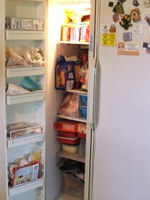Prairie Fare: How Much Do You Know About Frozen Food Storage?
(Click an image below to view a high-resolution image that can be downloaded)
By Julie Garden-Robinson, Food and Nutrition Specialist
NDSU Extension Service
I like to peruse antique stores. Sometimes I spot things that I do not recognize, even after years of collecting.
Awhile back, I came upon a golden oak chest with three doors and bronze handles. It carried a fairly hefty price tag.
At first I thought it was a dresser. I opened a door and my husband and I studied it a bit.
“That’s an icebox,” we said simultaneously.
People would fill the ice box with small blocks of ice from a local “ice house” to keep perishable food cold and safe longer. What I found interesting was that the price of the ice box was more than the cost of some modern-day refrigerators.
Our ancestors had to work harder to maintain cold storage temperatures. Fortunately, we don’t have to fill wooden chests with ice to maintain cold food storage areas in our homes.
Mechanical refrigeration units were developed in the late 1800s, and later, Clarence Birdseye perfected a quick-freezing method that ensured high-quality frozen food.
In earlier times, people in climates with cold winter months had access to a very large ice box by simply walking outside. However, we do not recommend storing food in snowbanks for many reasons.
Freezing is one of the easiest and most convenient ways to preserve food if you have the proper equipment. Frozen food will remain safe indefinitely, but the quality (flavor, texture, appearance, etc.) can decrease with time.
How much do you know about frozen food storage? Try these questions. The answers are at the end.
- At what temperature should your freezer be maintained?
- Name three types of containers that are not suitable for freezing food.
- When you prepare food for freezing, how should you label the food?
- Scenario 1: You decided to bake cookies for the holidays last July. If they were packaged correctly and held at the appropriate temperature, for how many months will the cookies maintain their quality?
- Scenario 2: You baked a fruit pie and froze it. How long will the frozen pie be of high quality?
- Scenario 3: You made spaghetti sauce with meat and froze it in appropriate freezer containers. For how many months will it maintain its quality when appropriately frozen?
- Scenario 4: You made extra stuffing and froze it. a. How long will it maintain its quality in your freezer? b. How should you thaw it? c. To what internal temperature should you reheat it?
- Scenario 5: You made meat loaf and did not precook it prior to freezing. a. To what internal temperature should you cook the meat loaf after thawing? b. If packaged and stored correctly, how many months will it remain of high quality in your freezer?
- Why are milk-based sauces and gravy considered “problem foods” in freezing?
- Bonus question: On average, how many pounds per cubic foot of freezer space should you freeze in a 24-hour period?
How did you do? Here are the answers:
- Your freezer should be maintained at 0 F.
- Avoid freezing foods in margarine, yogurt or cottage cheese containers; narrow-neck glass jars that could break when the food expands during freezing; or trays that came with microwavable entrees.
- Label frozen foods with the date and contents using a permanent marker to avoid “frozen food surprise.”
- Cookies maintain their quality about six months in the freezer. The cookies made in July still would be OK in December.
- When stored correctly, frozen fruit pies maintain their quality for three to four months.
- Frozen spaghetti sauce maintains its quality for four to six months.
- Frozen stuffing: a. Frozen stuffing will maintain its quality up to one month. b. Thaw stuffing in the refrigerator. c. Reheat stuffing to an internal temperature of at least 165 F, as measured with a food thermometer.
- Frozen meat loaf: a. Cook the meat loaf to an internal temperature of at least 160 F. b. Frozen meat loaf will remain high quality for three to four months.
- Milk-based thickened sauces and gravy tend to “curdle” or separate. They are best when made fresh and served immediately.
- You can freeze 2 to 3 pounds of food for every cubic food of freezer space every 24 hours. This allows food to fully freeze.
The National Center for Home Food Preservation has a handy reference about frozen food storage. You might want to bookmark it on your computer or print a copy to have in your kitchen. Visit http://nchfp.uga.edu/publications/uga/FreezingPreparedFoods.pdf to download a copy.
Visit www.ag.ndsu.edu/food and click on “Food Preservation,” then “Freezing,” to access how-to guides for freezing almost any type of food.
Here’s a convenience food recipe adapted from one from the University of Kentucky. Consider doubling the recipe to make one batch for dinner and another to freeze for an easy meal later.
Bake and Freeze Spaghetti Casserole
8 ounces uncooked pasta (elbow macaroni, bow ties or spaghetti)
1 Tbsp. canola oil or other oil
1 1/2 c. canned chicken (drained)
2 cloves garlic (chopped)
1 tsp. dried oregano (optional)
1/4 tsp. black pepper
2 (15-ounce) cans low-sodium tomatoes, not drained
3/4 c. reduced-fat cheddar cheese (shredded)
Preheat oven to 350 degrees F. Cook pasta according to package directions. Drain and place in a 9- by 9-inch baking dish. In a large skillet over medium heat, combine chicken, garlic and pepper. If using oregano, add that, too. Cook in oil until hot, about five minutes. Stir in tomatoes. Lower the heat and cook for 10 minutes. Spoon tomato and chicken mixture over the pasta in the baking dish. Sprinkle with cheese. Bake for 30 minutes or until hot and bubbling. Serve immediately or cool to room temperature, then freeze up to three months.
Makes six servings. Each serving has 340 calories, 12 grams (g) fat, 22 g protein, 35 g carbohydrate, 4 g fiber and 360 milligrams sodium.
(Julie Garden-Robinson, Ph.D., R.D., L.R.D., is a North Dakota State University Extension Service food and nutrition specialist and professor in the Department of Health, Nutrition and Exercise Sciences. Follow her on Twitter @jgardenrobinson)
NDSU Agriculture Communication - Nov. 22, 2017
| Source: | Julie Garden-Robinson, 701-231-7187, julie.garden-robinson@ndsu.edu |
|---|---|
| Editor: | Ellen Crawford, 701-231-5391, ellen.crawford@ndsu.edu |



